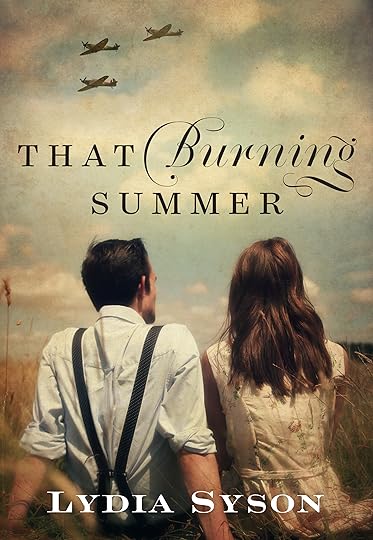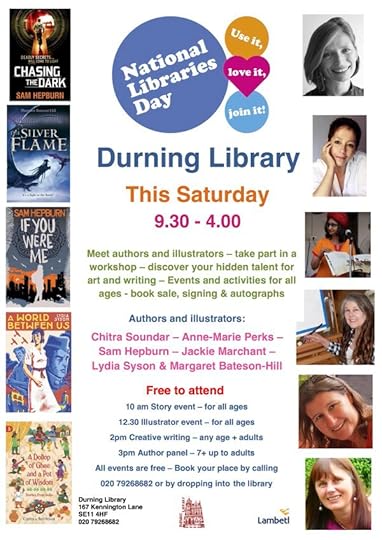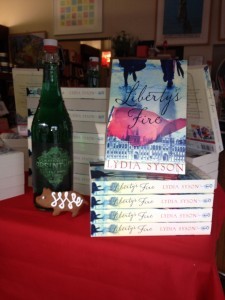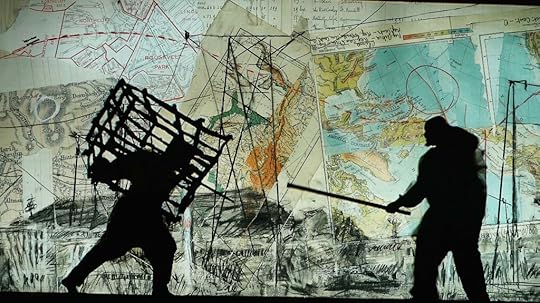Lydia Syson's Blog, page 3
March 8, 2016
Judith Kerr
Barely had I written this appreciation of Judith Kerr for The History Girls than I discovered that When Hitler Stole Pink Rabbit was the subject of this month’s World Book Club programme on the BBC World Service. What joy! (Nb that is permitted usage of the exclamation mark according to new DoE regulations. The following isn’t.) One of my all-time favourite children’s writers talking to my all-time favourite books presenter, Harriett Gilbert! You can listen yourself or download the programme here.
Happy International Women’s Day!
That delightful photograph was taken by Enda Bowe for Jewish Book Week.
31st March 2016: Children and Socialism series, Marx Memorial Library, London
New Ways to Tell Old Stories: putting the political into historical fiction for today’s young readers
Lydia Syson and Meirian Jump in conversation at the home of the International Brigade archives.
Lydia, a former BBC World Service radio producer, is the author of three critically-acclaimed novels for young adults. A World Between Us (2012) tells the story of three British volunteers in the Spanish Civil War. Sparked by research into the anthem of the International Brigades, Liberty’s Fire (2015) brings the 1871 Paris Commune dramatically to life for a new generation. That Burning Summer (2013) is set during the Battle of Britain in small rural community where spyfever is infectious and pacifism a dirty word. Lydia and Meirian will discuss hidden histories, unexpected heroes, archives and sources, and the ethics of turning real lives into fiction. All welcome. No need to book. £3 on the door.
March 31st, 2016 7:00 PM
Location:

Marx Memorial Library
37A Clerkenwell Green
London
EC1R 0DU
United Kingdom
Phone: 020 725 31485
February 26, 2016
US Cover Reveal
A complete change of style for the new cover of That Burning Summer which is coming out with Sky Pony Press in the US next January. I’m delighted with it. It captures the mood of the book and its setting beautifully. I can’t wait to see how it goes down with American readers. Over to Christina Sapyta at Confessions of a Book Addict…
You can find out more about Christina here.
February 3, 2016
February News: National Libraries Day and Ebook Special Offers
If you value your local library, this Saturday is the day to show your appreciation. Find out what’s going on near you here. Southwark residents like me have lots to celebrate, as our council has not only worked hard through the cuts to keep libraries open, but in Camberwell we’ve even got a brand new one, open seven days a week, and it’s glorious. It’s hard to imagine a greater contrast to the dank, windowless basement that used to be Camberwell’s children’s library. Things are very different just over the border in Lambeth, where half the borough’s libraries are threatened with closure, and at least three are currently due to become gyms with a few bookshelves. You can sign a petition to save Lambeth Libraries here and read something I wrote for NLD a few years ago here, and a 2012 ‘Speak up for Libraries’ blogpost here. On Saturday afternoon I’ll be joining other CWISL authors to welcome readers of all ages to Durning Library…do come along. I’ll be on the author panel at 3pm. Full details below. Find out what’s going on near you here.
 Other news…this month ebook editions of Liberty’s Fire are on special offer, February being the month of romance and all that. It’s a ‘Romantic Read’ at Sainsbury’s until February 15th, in the sale at Nook all through February, and Kobo has a Valentine’s Day offer that runs from 11th – 15th Feb. That Burning Summer and A World Between Us are even more of a bargain right now at all these ebookshops, but specially at Nook. So hearts all round.
Other news…this month ebook editions of Liberty’s Fire are on special offer, February being the month of romance and all that. It’s a ‘Romantic Read’ at Sainsbury’s until February 15th, in the sale at Nook all through February, and Kobo has a Valentine’s Day offer that runs from 11th – 15th Feb. That Burning Summer and A World Between Us are even more of a bargain right now at all these ebookshops, but specially at Nook. So hearts all round.
These promos have got me realising that I really need to get my head round all the different ebook formats. As an early fan of e-readers, I tend to read on a Kindle, so I’m slightly in thrall to Amazon, frustratingly, and that’s the format I’m most familiar with. My Kindle has transformed research for me thanks to the accessibility of out-of-copyright texts, and I don’t think most people realise what a difference ebooks have made for people who are partially sighted. But I must admit that although I’m still feeling my way with ePub editions, one thing I’ve just learned is that these are the eBooks you can actually borrow from your UK library, publisher permitting. (Has anyone tried this?)
This is probably the most useful basic guide to ebook formats I’ve ever found, and here’s a list with links to 10 different ways to open/read ePub files. I’ve still not tried Calibre, and would love to know how others find it.
I also read books on an iPad, such as pdfs of manuscripts and in recent years a great many 19th century editions from Internet Archive. I’m just very sorry that Apple has done so little to publicise the difference between a normal eBook and and an enhanced iBook, as I’m still extremely proud of Hot Key Book’s all-singing, all-dancing edition of A World Between Us, which includes interviews with Spanish Civil War historians Paul Preston and Richard Baxell as well as David Lomon, the last surviving International Brigader in Britain, who sadly died shortly afterwards. There are also photographs, maps, music, links to archives…and now you can read it on an iPhone or Mac as well as an iPad, which you couldn’t before. Available from iTunes.
Of course I’ll never stop reading books with real pages, but I can’t now imagine life without ebooks, any more than I can imagine life without libraries. Anyone else feel the same way?
January 6, 2016
Happy ‘Nu’ Year
My New Year’s resolution should possibly be to work out how to exert better control over my headline images on WordPress…In fact, instead of website improvement, I’ve been preoccupied with 1950s home improvement at The History Girls this month, where I wonder if that whole decade wasn’t one big cover-up. The post - The Mastery of Knack - was inspired by a Christmas present, a copy of The Practical Householder of October 1956.
Steven Pinker’s The Sense of Style: The Thinking Person’s Guide to Writing in the 21st Century was another recent present, equally engrossing, and the perfect read for those of a logical yet rebellious disposition. Pinker’s approach is as practical as a DIY manual: he decisively demolishes the myth of an undying battle between language Prescriptivists and Descriptivists, and clears up after himself very well too. In my tutorials at The Courtauld where I’m a Royal Literary Fund Writing Fellow, I’ve already been finding the concept of prose-deadening ‘zombie nouns’ which he discusses here extremely useful. Pinker adopts this nickname for nominalizations from Helen Sword, citing her example: The proliferation of nominalizations in a discursive formation may be an indication of a tendency towards pomposity and abstraction. In other words, ‘Writers who overload their sentences with nouns derived from verbs and adjectives tend to sound pompous and abstract.’ His vigorous attack on the comma splice is extremely cheering. I will undoubtedly be recommending The Sense of Style on a weekly basis this term, and pillaging it frequently too. I resolve to worry less when I read ‘like’ instead of ‘as’ but – as a die-hard pedant – I’m sure I’ll retain my irrationally purist use of disinterested, hopefully, and enervate. And I definitely agree that unsplit infinitives usually simply sound better, even if they have no convincing grammatical justification.
The first working week of the year has brought a number of other unexpected pleasures: sneaking into the company of Elena Ferrante, Marlon James, Evie Wyld, Muriel Spark and others in my Review bookshop’s list of Top Ten Bestsellers of 2015 (It’s official! Liberty’s Fire is a bestseller…in SE15, at least!); reading four different accounts of an 1867 shipwreck on a Polynesian coral reef in the London Missionary Society archives at SOAS; and seeing the glorious new cover proposed for the US edition of That Burning Summer which will be published by Sky Pony Press this autumn.
This year is the 80th anniversary of the outbreak of the Spanish Civil War, and there are quite a few conferences on the subject coming up, including The Spanish Civil War and World Literatures in London in July, where I’ll be talking about the writing and reception of A World Between Us. I’m also looking forward to the Len Crome Memorial Conference this March which is about women in Spain – and particularly to Linda Palfreeman’s paper on Fernanda Jacobsen of the Scottish Ambulance Service (‘Samaritan or Spy?) Book your place here. Birkbeck’s Crossing Borders also looks promising.
My other new year’s resolution is to update my ‘further reading’ sections with more of the material that’s come out on all my various interests since the publication of my own books. Luc Sante’s The Other Paris could hardly be more up my street. The ultimate twenty-first-century flâneur, Sante (interviewed here in The Paris Review, and here last weekend in The Guardian) observes the underbelly of the city and the drift between past and present with a fine sense of style. Anything but nostalgic. Highly recommended.
December 22, 2015
Len Crome Memorial Conference 12th March 2016: Women and the Spanish Civil War
December 13, 2015
Gingerbread Pigs
My kitchen is heady with the scent of cloves and ginger and muscavado and cinnamon. The biscuity part of our gingerbread house is ready to be stuck together with icing, and adorned with sweets. We will eat it on New Year’s eve. Having managed to burn a few trayfuls during supper last night, we’ve still got more hearts and stars and snowflakes for presents and tree-hanging and emergency fuel to cut out and bake, and also, this year, pigs.
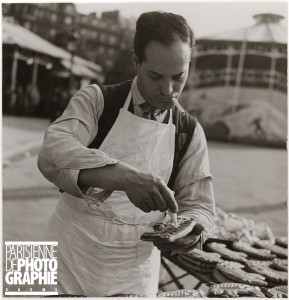
Confectioner decorating a pig-shaped gingerbread, Foire du Trône fun fair, Paris (XIIth arrondissement). 1933. Photograph by Roger Schall (1904-1995). Paris, musée Carnavalet.
© Roger Schall / Musée Carnavalet / Roger-Viollet
In Liberty’s Fire, Anatole meets Zèphyrine at the Foire du Trône, and their love is kindled on the swingboats, while the iced gingerbread pig he has bought her nestles uneaten in her lap. The scene came to me as soon as I read about the gingerbread fair. Despite the fighting raging outside Paris, the show went on, and the fair can be seen a celebratory moment of defiance, the perfect illustration of the carnivalesque element of the Commune, ‘le temps de cerises’.

Gingerbread fair. The Dutch spinning top. Paris, about 1894-1895.
© Léon et Lévy / Roger-Viollet
The Foire du Trône is still held in Paris each May, still in the 12th arrondissement, although now it’s now a gigantic funfair, and lovers are swung against each other in stomach-emptying rides like ‘Le Star Flyer’. But you can still buy gingerbread pigs.
I made hundreds of pigs last May for various Liberty’s Fire events, and I must confess I’ve not tried another recipe for gingerbread, but since Prue Leith’s one hasn’t let me down in nearly two decades, I’ll share my version of it with you now. It’s got just the right amount of kick and snap, and the biscuits last for ages without going soggy. Doubling the quantities will give you enough for a house and plenty of biscuits. I usually triple them, because the mixture also freezes well and it’s always good to have an emergency batch. Make holes with skewers before biscuits harden if you want to hang them up, and don’t be tempted to mix the dough with a machine as it needs more delicate treatment.
OLD-FASHIONED GINGERBREAD
340g/12oz plain flour
1 teaspoon baking powder
1 teaspoon salt
1 teaspoon fresh grated nutmeg
1 teaspoon freshly ground cloves
2 teaspoons ground cinnamon
2 teaspoons ground ginger
225g/8oz butter
225g/8oz caster sugar
170g/6oz soft dark brown sugar (muscavado)
2 eggs beaten
1. Preheat oven to 180 degrees C/350 F/gas mark 4
2. Melt the butter in a saucepan, add the sugars, mix well and allow to cool before adding the eggs.
3. While the butter is cooling, sift the flour, baking powder, salt and spices into a large bowl.
4. Make a well in the dry ingredients and gradually add the butter and sugar mixture. Put in the fridge until completely cold and much stiffer.
5. Divide into manageable lumps, roll out and cut out with your favourite cutters, and put on lined baking sheets. If you’re doing a lot, put one tray in the fridge while you’re doing the next.
6. Bake for about 10 minutes but keep a close eye on them!
You can find more photographs of the Gingerbread Fair, and of course the Paris Commune, and much more at Paris en Images. This website offers free access to 110,000 photos from the Roger-Viollet archive as well as the collections of the Paris Historical Library, the City Hall Library, Forney graphic arts Library, Musee Carnavalet and the collection of photographer Pierre Jahan, among others.
Other news…I’ve written about the almost-Impressionist artist Bazille, his intriguing portrait of Renoir and the ‘invention’ of homosexuality at The History Girls this month. And I felt Christmas had come early when I read this fabulous review of Liberty’s Fire in Armadillo, the children’s book review magazine.
My recipe comes from Leith’s Cookery Bible by Prue Leith and Caroline Waldegrave (Bloomsbury, 1996).
October 19, 2015
‘Resist the attempt to construct an argument’
This slogan flashed by while I sat enthralled by William Kentridge’s video installation Notes Towards a Model Opera at the Marian Goodman Gallery in Soho, London. It made me smile because I now spend two days a week as a Royal Literary Fund Writing Fellow at the Courtauld Institute for the History of Art encouraging students to construct an argument. Yet when I’m writing fiction, arguments are something I know I have to resist, despite my political themes.
Notes Towards a Model Opera forms part of a mesmerisingly immersive show which spoke uncannily to many of my current and long-term obsessions, articulating but not arguing its ideas with profundity and panache. Words and images, repeatedly and rapidly overlaid, appeared and vanished with strobe-like intensity. I recognised photographs of Communards in open coffins, pages from the Commune’s official newspaper, ink-wash Manet-esque flowers flying away on scattering printed pages, calligraphy transformed itself into doves in flight. I may have seen the scribbled words of Marx – a reference to Parisians ‘storming heaven’. I’m sure I saw maps of China, of Africa in Russian, of the Paris suburbs. A megaphone reminded me of the conical hats of the Spanish Inquisition or the Klu Klux Klan. Meanwhile two dancers performed balletic propaganda to a soundtrack constructed of different versions of the Internationale – a jaunty ‘period’ brassband, a lone Chinese voice, a South African protest song.
I’ve written elsewhere about the emotional significance in my writing of the Internationale, the socialist anthem we sang at both my grandparents’ funerals, and which I now sing each year if I possibly can at the annual commemoration of the International Brigades on London’s South Bank: it was the song that united anti-fascist volunteers from just about every corner of the world during the Spanish Civil War. The lyrics were written just after the fall of the Paris Commune. This discovery set me off a few years ago on the trajectory that led from A World Between Us to Liberty’s Fire, from 1936 to 1871.
Opera became a driving force of the plot of Liberty’s Fire for all sorts of reasons. My earliest impressions of nineteenth-century Paris were layered from from performances I’d seen of La Traviata, La Bohème, Manon Lescaut. Participants in the Commune on both sides of the political divide frequently perceived the events in which they were caught up as ‘operatic’ in nature, and many Communards played up to this, performing their political duties in elaborate costume, relishing the drama involved. Making reference to Madame Mao, and also China’s current impact on Africa, Kentridge evokes the sense of revolution as musical spectacle – and vice versa – quite brilliantly. The Commune used opera as a tool of revolution, embracing ‘high’ as well as ‘low’ musical art forms to raise funds, maintain morale, and open up all of Paris to its whole population, rich and poor. Delphine Mordey, whose work introduced me to these ideas, (details here) argues that in staging (or attempting to stage) musical events at the Tuileries and the Opéra, the workers’ government ‘frequently described. . .as barbaric and primitive, sought legitimation through the appropriation of the space and culture of the ousted ruling classes. Ultimately this plan would backfire: far from being taken seriously, the Communards would be described by their critics as little more than characters in their own operatic drama.’
‘Attempting to stage’ is significant, as Kentridge is undoubtedly aware. Extracts from the Commune newspaper, the Journal Officiel, printed in this show on the torn-out-and-glued together pages of an encyclopedia, include a notice addressed to ‘artistes musiciens’. It invited the orchestral musicians of Paris’ musical theatres to an important meeting at the Opéra at 2 pm on Monday 8th May. I suspect this was the meeting to plan the performance to be staged there on May 21th, though I’ve not yet had time to check, which included the last act of Il Trovatore. I took the liberty in Liberty’s Fire of giving the part of Leonora in to my character Marie. I don’t want to spoil anyone’s enjoyment of the book by saying here what actually happened.
Print, palimpsest, occupation. One thing leads to another. One revolution is overlaid by the next. Here and even more so in the the upper gallery, which is dedicated to a second installation, More Sweetly Play the Dance, still more monumental and ambiguous, the abiding impression is one of progression without progress, though not devoid of hope.
A procession of figures appears, many carrying images we have already seen downstairs. A brass band, a trio of skeletons, orators, stenographers at work, patients dragging their drips…all dance off into the unknown in a style that is stately and medieval-macabre, and I can’t take my eyes of Dada Masilo, the lone uniformed dancer who brings up the rear, duetting with her weaponry as she also does in Notes towards a Model Opera. With just a few touches of red, More Sweetly Play the Dance unfolds like grisaille in motion across an empty, charcoal-drawn veldt landscape. It’s reminiscent of an early nineteenth-century panorama, an art form historically seen as both deceitful and sublime. It’s impossible not to think of the thousands of refugees making their way, with great dignity, across the world at this moment.
This exhibition runs until 24th October at the Marion Goodman Gallery, 5-8 Lower John Street, London. Here’s an interview with the artist by Emma Crichton-Miller in Apollo magazine. Find out here where you can watch Kentridge’s production of Berg’s Lulu ’Live from the Met’ on November 21st.
All images:
Copyright: William Kentridge
Courtesy: The artist and Marian Goodman Gallery
WILLIAM KENTRIDGE
Notes Towards a Model Opera, 2014 -2015 3-channel video installation, sound
HD video 1080p / ratio 16:9
Duration 11 minutes 14 seconds (includes credits)
WILLIAM KENTRIDGE
More Sweetly Play the Dance, 2015
8-channel video installation with four megaphones, sound
HD video 1080p / ratio 16:9 duration 15 minutes (includes end credits)
Copyright: William Kentridge
Courtesy: The artist and Marian Goodman Gallery Photo Credit: William Kentridge studio
On another note entirely, I’m delighted to say that the 2016 Carnegie award nomination list was published today, and that Liberty’s Fire is on it. Many thanks to all the brilliant and committed librarians who work so hard to make both the Carnegie and the Kate Greenaway medal the most valued and prestigious of all the children’s book prizes in this country. A great honour.
October 2, 2015
In which I go ‘Down The Rabbit Hole’…
…with fellow History Girl, Catherine Johnson. A little over a year ago, the world of children’s literature cheered the launch of a brand new radio programme, DOWN THE RABBIT HOLE, broadcast from the creative and groundbreaking station Resonance FM. Once a month, a thoroughly expert team – Katherine Woodfine of Booktrust, Louise Lamont of LBA and Melissa Cox of Waterstones – put together a book-packed 30 minute show which has proved itself an unmissable and wide-ranging guide to everything that’s new in children’s books. I know I’m addicted to archives, so I would say this, but trust me – the DTRH one is more accessible than most and well worth exploring!
Needless to say, I jumped at the chance to compare notes on writing historical fiction with Catherine, whose latest novel, The Curious Tale of the Lady Caraboo brilliantly re-imagines the story of one of Enlightenment England’s most intriguing impostors.*
Listen to the complete September edition of DTRH here with illustrator David Roberts and author Katherine Webber on Mixcloud (including news and views of latest books by two authors who happen to be extremely popular in my household, Sarah Crossan and Brian Selznick). Highlights of our thoughts about school history, research, rewrites and history from below can be heard here and (if you’re really keen) the whole conversation is available here.
Many thanks to Wei Ming Kam for organising and editing this feature – there was so much to talk about we certainly didn’t make that easy. You can follow DOWN THE RABBIT HOLE on Twitter here - look out for regular competitions with new books as prizes - and find the show (and its entire, wonderful archive) on Tumblr here.
*The ever-inventive ‘Princess’ fooled Gloucestershire for months in 1817, the year after an African-American sailor called Robert Adams appeared in London claiming to have been taken in captivity to Timbuktu. How Adams’ Narrative was reproduced and received was central to my 2003 PhD about imagining Timbuctoo in the 19th century.
More from me on historical fiction coming up next week at the History Girls, where I’ll be thinking about slang, lexicography and the dangerous temptations of the ‘Vulgar Tongue’.
September 17, 2015
Who are you like?
UKYAX is all about breaking down barriers between readers and writers, and finding new ways to spread the word about books. With that in mind, Chelley Toy and I have had emails flying back and forth all week concocting a quiz to whet your appetite for the Nottingham event, and introduce you to some of the characters in my novels. Now step this way to discover your (historical) fictional twin…
Here’s the full schedule for the UKYAX blog tour leading up to 10th October….
Next stop, tomorrow, will be Zoe Marriott at Writing from the Tub. And in case you’ve been wondering what being a book-blogger involves, here’s my UKYAX blogging-partner Chelley – UKYABA Champion Newcomer 2015 - to introduce herself and her book-blogging life. Huge amounts of thanks to Chelley for taking up the quiz idea and running with it…and thanks to Sanne Vliegenthart at Hot Key Books for setting us off in the right direction.

Hi, I’m Chelle and I run Tales of Yesterday.
I have always loved books and I took the step of starting a blog through this love that I have. It really felt like a natural progression for me. I went through a bit of a traumatic time a couple of years ago when I suddenly and without reason lost my sight in my right eye. It was a tough time, I couldn’t read for a while with my left eye and I guess my brain couldn’t concentrate on things properly and my sight has not returned. After a while I picked up a UKYA book (Hollow Pike by James Dawson) and started reading it and fell completely in love with reading again and the whole YA community.
Now I read lots of books and review them on my blog and also love to feature guest posts, Q&As amongst others things, from authors as well as other bloggers. I always feature anything I enjoy or find fun or want to know the answers to. I love the fact that I can discuss books through my blog or on twitter with other people who have read the books. It’s lovely to hear different opinions and thoughts. I have made so many wonderful friends through blogging, other bloggers, authors, publicists etc and each and every single one has touched my heart! The book blogging community is THE BEST!
I’m also a co-mod for the awesome book forum BookishPeeps.com and organiser of #DrinkYAMidlands and #PicnicYAMidlands where everyone is welcome to meet up for bookish chat and fun! I also host a nostalgic #PointHorrorBookClub on the 13th of every month where we read and discuss a Point Horror book which were all the rage and loved by myself in the 90’s – do you remember them?
I am helpdesk/resource planner team leader for a service company by day and an avid book reader/book blogger/serial tweeter/twitter addict by night and on weekends! I am often known to be a little bit clumsy and possibly a little loopy! I am always laughing at something or another and have a bit of a chuckle laugh (one of my managers calls me chuckles). I live with my husband, Kevin, who I have known since I was 4 and I have a 10 year old son, Corey, who is as much of a book-lover as me. I also have 3 cats, Skittles, Patch and Louis who enjoy clawing at my curtains, and 3 rabbits, Smudge, Caramel and Clover, who pinch all my vegetables! I am a book-loving (obsessed), theatre-loving, slasher-horror film loving csi geek! I’m often (very often) seen on Twitter embarrassing myself and tweeting about books using @chelleytoy. I also have a thing for Homer Simpson……
If you enjoyed the quiz, do send a link to a friend. Don’t forget that the inaugural UKMGX for Middle Grade authors and their fans is taking place at Nottingham Central Library on 17th October with this equally enticing line-up of writers…including my fellow-CWISL-authors Mo O’Hara and Jackie Gardner… (Sophia Bennett will be appearing with me at UKYAX).


